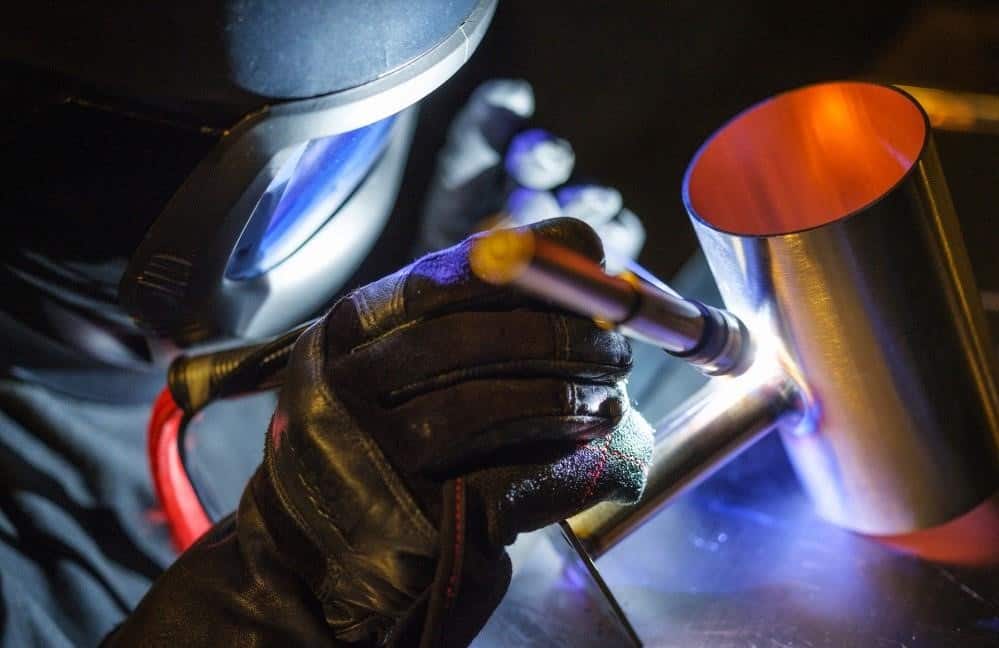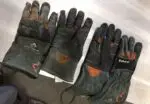The two most common types of welding methods include TIG welding and MIG welding. The basics might be the same, but some of the dangers differ. Hence, for each welding type, you need special gloves.
The most basic requirement is high-quality flame-resistant gloves for welding. No matter the type (MIG or TIG), flame, sparks, and heat are the constants. That’s why you cannot use normal cotton or regular wool gloves for welding.
You need special high-quality gloves that can offer protection from all the dangers of welding. Welding gloves should be made out of pure leather that’s temperature-resistant, heat-resistant, as well as fire-resistant.
Welders can also consider wearing rubber gloves that offer protection from heat exposure due to long working hours.
The type of welding gloves that’ll be most suitable also depends upon the weather conditions the welder is working in and the type of welding being carried out (TIG or MIG).
To be more precise, there are many things that one has to consider when choosing the right pair of gloves for welding. This guide is about all such factors. Skim through and explore which types would be the most suitable options for you.
Can You Use Normal Gloves for Welding?
ASTM and ANSI lay down specific guidelines for work hazards involved in welding. Welders are at serious risk of burns, electric shocks, and cuts.
The amount of heat involved in welding is soaring high. Naturally, normal cotton gloves, examination gloves, or wool gloves cannot protect from work hazards involved in the business of welding.
To put it simply, you cannot wear normal cotton or wool gloves for welding. Welding gloves should be extremely resistant to heat and flames.
As long as the gloves do not follow the safety guidelines for welding work hazards, they’re unsuitable for welders.
Guidelines for Welding Gloves – Does it Matter?
According to ANSI, ASTM, and MCR, heat, sparks, and flames are the major threats involved in welding. Hence, it’s thermal protection that’s the most important feature when choosing the right gloves for welding.
The American safety organizations for workplace hazards for welding focus on hand protection from heat. Certain guidelines for welding gloves that are very important are as follows:
1.) Welding gloves should be insulated.
2.) Full-grain leather is more suitable when the work is dexterous.
3.) Welding gloves should spread from fingertips to cuffs to offer complete protection.
4.) Gauntlet cuffs are better options.
5.) The fingertips should have extra padding.
6.) Welding gloves should offer protection from second-degree burns for a minimum of 15 seconds.
These guidelines are specifically suggested so that welders do not sustain injuries from fire and flames. It’s always the duty of organizations to provide the highest quality welding gloves to their workers.
If you’re an independent welder, make sure you invest in the right pair of welding gloves for optimum protection.
What Kind of Gloves do You Need for Welding – The Best Fabrics!
There are basically 5 features that a welding glove should have to offer overall protection. Only when all the conditions are met that the glove will be called a special welding glove. Let’s explore all 5 features.
Important Features for Welding Gloves
#1. High Resistance to Heat
Did you know that the temperature of a welding arc can range anywhere between 6000°C to 8000°C?
Naturally, a welding glove should be able to offer protection from high levels of heat so that it can protect a welder from a second-degree burn if the welder accidentally touches the arc for a minimum of 15 seconds.
#2. Resistance to Puncture and Cuts
Heat isn’t the only threat. Cuts from sharp metal edges are also looming threats. Thus, a welding glove should be puncture-resistant too.
#3. Resistance to Flame
Flame resistance is a mandatory condition, not an optional feature. If a glove cannot offer protection from flame and flying sparks, it’s not a suitable welding glove.
#4. A Strong Grip and Resistance to Friction
Dropping a burning hot blowtorch while welding exposes the feet to the threat of sustaining burn injuries. Hence, it’s very important that the gloves you’re wearing while welding offer a very strong grip.
Besides, friction resistance is a necessity too. Hence, it’s important that you find welding gloves that are the right size.
It’s also recommended that you wear cotton gloves under the welding gloves to mitigate the chances of friction.
#5. Resistance to Moisture
Moisture is again another threat that can create friction and affect your efficiency. Hence, a welding glove should be able to wick all the moisture.
Suitable Fabrics for Welding Gloves
Not every fabric can be used to make welding gloves. The two most preferred choices are leather gloves and rubber gloves. But, there are some other options too when the work is less dexterous.
Let’s explore all the options in detail.
→ Leather gloves – Leather has all the qualities and aforementioned features. Hence, it’s the number one choice of materials for welding gloves. (How to Clean Leather Welding Gloves?)
The different types of leathers that are used to make welding gloves include Cowhide leather, Pig leather, Deer leather, Elk leather, and Goat leather.
→ Rubber gloves
→ Thinsulate gloves
→ Kevlar gloves
→ Aluminized gloves
Things to Look for When Buying Welding Gloves
There are many fabrics that welding gloves can be made of. The variation in the fabric is usually proportional to certain differences in welding. Those differences – listed below – are what you should look at when buying welding gloves.
The weather – Different fabrics offer comfort during different weather conditions. For instance, when it’s snow cold, leather gloves with Thinsulate lining are one of the best options. (Can You Weld When Its Cold?)
Similarly, the cotton lining is good when it’s moist or too hot. So, always keep the kind of weather you’re welding in for optimal comfort.
The level of protection required – Different metals, different types of welding methods (MIG welding and TIG Welding), and different conditions (indoor welding and outdoor welding) require different levels of protection from heat and flames.
Pick the type based on the maximum temperature you’ll be exposed to, the wind speed, and so on.
Can You Use TIG Gloves for MIG Welding – What’s the Difference?
The very fact that TIG welding is different from MIG welding should give you an idea that different levels of hand protection are required in both types.
Though sometimes TIG gloves are used for MIG welding and vice-versa, you must understand that it’s applicable in very few scenarios.
In order to understand things better, you need to understand the difference between these gloves types. Let’s cut the chase and dive headfirst into the differences!
1.) MIG Welding Gloves: MIG welding exposes the hands to higher degrees of heat. Hence, MIG gloves are thicker and loose.
2.) TIG Welding Gloves – TIG welding gloves need to offer a snug comfy fit. The major danger in TIG welding is light. Besides, these gloves are thinner than MIG gloves.
Since the dangers are so different, the welding gloves are quite different too. The only two scenarios when TIG gloves can be used for MIG welding are:
1.) When MIG welding is being carried out at low power.
2.) When very small metal patches have to be welded together.
Concluding Thoughts:
You will always require special gloves for welding since welding is a risky job. Heat, light, and sparks are the most obvious dangers.
Since normal cotton or wool cannot offer protection from all the welding work threats, you require special welding gloves that will offer insulation, heat resistance, and fire resistance, all at the same time.
The most preferred fabrics for welding gloves are leather and rubber.
On a closing note, we hope that now you’ve understood why you require special gloves for welding and what you should look for when buying a welding glove.







